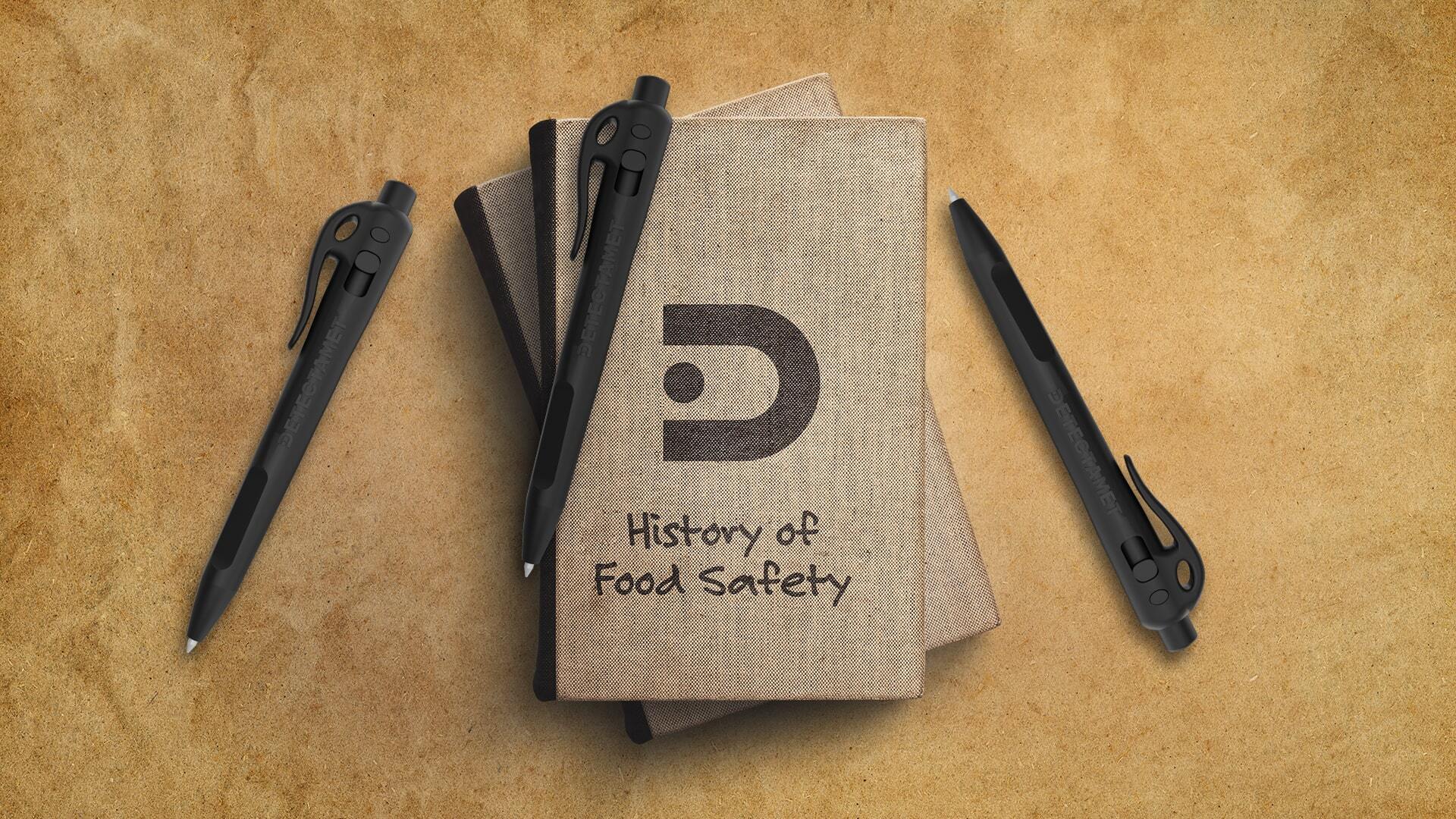The history of food safety: from metal detectors to x-ray systems

The history of food safety has been one of manufacturers versus contaminants. As such, food hygiene has always been a crucial concern in food manufacturing. Since your products are going to be eaten or drunk by customers, you have to ensure the user will come to no harm.
The methods used to ensure food safety have evolved significantly over time. From the early days of basic hygiene to today’s highly-regulated and technology-based systems, the journey of food safety reflects the growing complexity of our food supply chain.
As our understanding of contamination risks has deepened, so too has our commitment to ensuring that the food reaching consumers is free from harm.
The introduction and evolution of detection technologies, such as metal detectors and X-ray systems, revolutionised food safety practices and are now essential tools in protecting both consumers and brands.
So, let’s explore the evolution of food safety, focusing on how metal detectors and X-ray machines have transformed the industry.
The attraction of metal detection in food safety
The initial use of metal detectors in the food industry can be traced back to the 1940s, a time when food production was becoming more industrialised and the risks of contamination were more clearly understood.
Metal shards from machinery, broken tools and other sources posed significant dangers, leading to the development of metal detectors as a preventative measure.
The ‘balanced coil system’ is the most widely used type of metal detector in the food industry. In this configuration, the magnetic coils are wrapped around the aperture through which the product passes. This design was patented in the 19th century, but the first industrial metal detector wasn’t introduced to food processing until 1948.
Metal detectors work by creating an electromagnetic field. When a metal object passes through the detector, it disrupts this field, triggering an alarm that alerts operators to the presence of a contaminant. This technology quickly became a staple in food processing plants, as it provided a reliable and cost-effective means of identifying potentially dangerous metal fragments before they reached consumers.
But what about contaminants that aren’t metal or aren’t magnetic?
Seeing through X-ray inspection systems
The need to amplify the benefits of metal detectors paved the way for the development of X-ray inspection systems in the 1980s. X-ray technology is capable of identifying a wide-range of foreign objects, including glass, bone, stone and even certain plastics. This advancement was particularly important for food manufacturers dealing with products which are already packaged in metal containers, thus making traditional metal detectors ineffective.
X-rays pass through a product and measure the differences in density within the food. Denser materials, such as metal or bone, absorb more X-rays and appear darker on the resulting image, while less dense materials, such as food, appear lighter. This contrast allows the system to identify and isolate foreign objects, even within complex products or packaging. The ability to detect a variety of contaminants made X-ray inspection systems a game-changer for the food industry and they are continuing to improve, becoming ever-more energy-efficient and sensitive, making them both more sustainable and more efficient.
Modern food safety standards
Modern food safety standards are the product of lessons that have been learned over decades of improvement. Today’s standards focus on preventive measures and risk management to help manufacturers maintain safe practices and prevent foodborne illnesses.
While different regions may have their own regulatory bodies and frameworks, they all share the common goal of safeguarding public health. These regulatory bodies collaborate internationally, often aligning their standards to ensure consistency and safety. This collaborative approach is vital as food products frequently cross international borders.
The key regulatory frameworks include…
United States:
In the USA today, food safety is governed by the US Food & Drink Administration (FDA) through comprehensive frameworks like Hazard Analysis and Critical Control Points (HACCP), which require manufacturers to identify potential hazards and implement controls to mitigate them.
United Kingdom:
The UK Food Standards Agency (FSA) is the primary regulatory body responsible for food safety in the UK, ensuring that food manufacturers and retailers comply with safety standards.
European Union:
In the EU, food safety is governed by a comprehensive set of regulations aimed at protecting public health. The European Commission on Food Safety and European Food Safety Authority (EFSA) plays a central role, providing scientific advice and risk assessments that inform EU food safety laws.
Canada:
In Canada, the Safe Food for Canadians Act (SFCA) and the Safe Food for Canadians Regulations (SFCR) provide the foundation for the country’s food safety system, as overseen by the Canadian Food Inspection Agency.
Australia and New Zealand:
Australia and New Zealand operate under the umbrella of Food Standards Australia & New Zealand, who operate a joint food regulatory system called The Australia New Zealand Food Standards Code. This sets out requirements for food safety, labelling and additives. This code covers everything from contamination limits to genetically modified organisms (GMOs).
Metal Detectable and X-Ray Visible Products as standard
Detectamet is dedicated to helping businesses in their food hygiene efforts, by providing the world’s widest range of Metal Detectable and X-Ray Visible Solutions.
Ranging from all your stationery to workwear and PPE plus mixing and handling tools and more - everything Detectamet produces is engineered to be easily identified.
This detectability ensures that if any of these items accidentally enter the production line, they can be quickly detected and removed before reaching the consumer. It’s a tried and trusted process honed through the entire history of food hygiene.
Through the proactive incorporation of Detectamet products into your food safety protocols, you not only enhance your ability to comply with stringent food safety regulations, you also significantly reduce the risk of contamination that could lead to costly recalls and damage to your reputation.
The future of food safety
Looking ahead, the future of food safety will likely be shaped by even more sophisticated technologies. Artificial Intelligence is already being integrated into detection systems, enabling them to identify patterns and anomalies that might be missed by human operators. These technologies can analyse large volumes of data in real-time, improving the accuracy and efficiency of contaminant detection.
Additionally, more sensitive X-ray sensors are being developed that can detect even lower-density materials, such as thin plastic films or small bone fragments.
The future of food safety will also be shaped by the demands of consumers who are becoming more selective in their eating habits and more informed about the food they eat, driving demand for products that are not only safe but also ethically and sustainably produced.
That’s why we, at Detectamet, will be staying at the forefront of technological innovation and regulatory compliance by developing new products which help suppliers, manufacturers and retailers to ensure that they continue to deliver safe, high-quality products to their customers in an ever-evolving food safety landscape.
Conclusion
The journey of food safety, from the early days of basic hygiene to today’s advanced and ever-evolving detection technologies, reflects the food industry’s commitment to protecting consumers.
By investing in advanced detection systems and staying ahead of regulatory requirements, companies can ensure that they are well-positioned to meet the challenges of the future and deliver safe, high-quality products to consumers around the world.
And, we at Detectamet are here to help you with that, every step of the way.
Explore the full range of products here or speak to one of our food safety specialists about enhancing your food safety protocols with Detectamet’s innovative solutions.
 Detectamet USA (English - $ USD ) Click here to change your currency, region and language.
Detectamet USA (English - $ USD ) Click here to change your currency, region and language.








